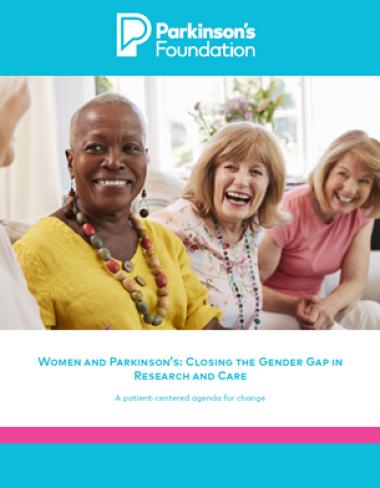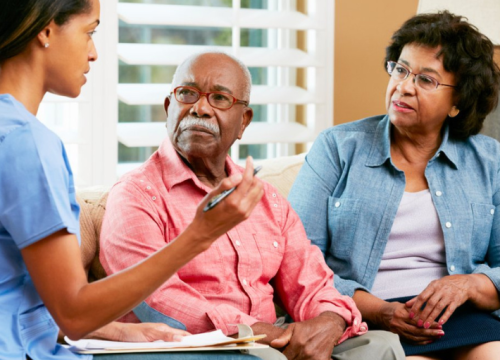Women & Parkinson’s

Sex and gender differences can drastically impact health and are important to consider when it comes to Parkinson’s disease (PD). With information and awareness of the key issues women with Parkinson's face, our hope is to help you feel empowered to advocate for the care and quality of life you deserve.
Sex and Gender
Sex is a biological identifier generally determined at birth (male or female).
Gender is how a person identifies.
There are differences in the way men and women experience Parkinson’s. While women are not adequately represented when it comes to Parkinson’s research, studies have shown that women with Parkinson’s:
- Are less often diagnosed and encounter greater hurdles to get an accurate diagnosis
- Report different symptoms compared to men with PD — such as more side effects and changes in symptoms throughout the day
- Are more likely to downplay symptoms
- Receive lower-quality healthcare than men
- Are less likely to seek treatment from a PD specialist, such as a neurologist or movement disorder specialist
More information and further research studying the differences between men and women with Parkinson’s are needed to ensure that women are receiving equal treatment and care.
Stories from Women with PD



Risk
Women have a lower risk of developing Parkinson’s, but the underlying reason for this has not yet been determined. Likely, the cause is due to several factors such as biology, environmental exposures and behaviors.
Treatment
Men and women take similar medications to combat PD symptoms. However, women are more likely to experience medication-related dyskinesias (involuntary, erratic movements), motor fluctuations and “wearing off” of medication.
Deep brain stimulation (DBS) is a treatment option that can help manage motor symptoms. Despite women having greater reported improvements to quality of life compared to men following DBS, women are less likely to receive the surgery.
Women also experience more non-movement symptoms than men with PD and are more likely to be prescribed antidepressants and benzodiazepines for anxiety. Pain management is similar for men and women living with PD.
Research
Women have been and continue to be underrepresented in Parkinson’s research. Research on women’s experience with PD underscores the need to focus on this important population of focus in the PD community.
Sex and gender differences are often not considered in both PD research and clinical care metrics but need to be, moving forward. Research has shown that:
- Women and men with PD report different symptoms and severity to their care team, but researchers have yet to identify women-specific symptoms.
- Small changes in medications or schedule can cause women to experience big changes in symptoms, with dyskinesias being the most frequently reported side effect.
- Women with PD are more likely than men with the disease to live and attend medical appointments alone.
Additional PD research should be conducted to understand how biological differences between men and women manifest in PD and how this affects treatment options.
The Parkinson’s Foundation believes that all Parkinson’s research needs to examine the effect of biological sex, including sex hormones, on PD risk, progression and response to treatments.

The biological reasons for the differences between the sexes are largely unknown and unexplored but nonetheless very important because understanding these differences could ultimately lead to personalized and more effective treatments that are targeted to males or females.
Estrogen Research
The relationship between estrogen and Parkinson’s is complicated and needs more research. Of the limited studies on estrogen and Parkinson’s, there is some data to support these theories:
- Hormones, namely estrogen, may be a factor in reducing PD risk in women.
- Estrogen may also be neuroprotective, possibly accounting for later PD onset in women.
- Longer duration on hormone replacement therapy (HRT) was associated with reduced risk of PD, although there has been conflicting data on this topic. We do not know if HRT can help treat fluctuations in PD symptoms.
Care
Since women are more likely to attend PD appointments alone and live alone, Parkinson’s care must be made more accessible and available to women.
Parkinson’s Foundation research has found that PD programs should target health, wellness and management of PD, and should be designed to be more welcoming to women. PD care programs must also focus on helping women feel comfortable and included.
Women with PD experience a greater quality of life when medical professionals work alongside them to manage care, identify treatment goals and minimize miscommunication. Medical professionals should focus on transparency, shared decision-making, and empathy to enhance communication between patient and clinician.
Mental Health
Women with PD have significantly less social support, more psychological distress, and worse self-reported health-related quality-of-life at initial PD care visits, compared to men.
Women with Parkinson’s can choose to prioritize their mental health through any treatment that they find beneficial — including finding a counselor, joining a support group or any other outlet that brings relief.
Mental Health & Parkinson's
Maintaining mental health is essential to living well with Parkinson's, and can help manage movement symptoms.
Pregnancy
Research on pregnancy and Parkinson’s is sparse. Parkinson’s does not appear to increase the risk of birth complications or birth defects. About half of women with Parkinson’s who become pregnant experience worsening of their PD movement symptoms during pregnancy, according to a review of the existing research.
Limited evidence suggests that levodopa can safely be taken during pregnancy. Breastfeeding while taking PD medications is typically not advised, because so little is known about their absorption into breast milk.
About 400 women under the age of 50 are diagnosed with PD in the U.S. each year. It is unknown how many become pregnant. There have been no formal clinical trials on pregnancy and Parkinson’s. PD researchers are working to collect data on women with PD who become pregnant, which would help develop guidelines for providing better care.
Learn More About Female Sexual Health
Tips for Women with Parkinson's
These tips can help women living with Parkinson’s navigate this disease:
- Seek expert care. Find a specialist who can provide a diagnosis and manage symptoms. It’s never too late to find a PD specialist you trust.
- Join a Parkinson’s research study. Help bridge the gender and sex research gap in the PD field.
- Work alongside your care team and PD doctor to identify goals for treatment.
- Report all symptoms and medication side effects to your care team.
- Find a support system that works for you. Women are more likely to go to doctors’ appointments alone, and not have a care partner. Find a support group, mental health professional, or group of friends that offer support.
Making an Impact

The Parkinson’s Foundation brings awareness to women-specific issues to help improve the health and well-being of women with PD. Women and Parkinson’s: Closing the Gender Gap in Research and Care is the first national research and care agenda specific to women with PD to address the disparities that they experience. Read the agenda now.
The Parkinson's Foundation believes in inclusivity when it comes to women in PD research. We fund women-specific Parkinson’s research grants and enroll women and men in our genetics study, PD GENEration: Mapping the Future of Parkinson’s disease.
Resources
Utilize these Parkinson’s Foundation tools at any time:
- Podcast: Encountering Gender Differences: Women and PD Initiative
- Women and Parkinson’s: Closing the Gender Gap in Research and Care
- Fact Sheet: Women and Parkinson’s Disease
- Call our Helpline at 1-800-4PD-INFO (1-800-473-4636) for answers to specific Parkinson’s questions, local referrals and more.
Page reviewed by Dr. Mara Seier, Assistant Professor in the Department of Neurological Sciences at the Nebraska Medicine Movement Disorders Center.
Related Materials
Related Blog Posts

The Unmet Needs of Women with Parkinson’s

Center of Excellence Series: University of Pennsylvania Movement Disorder Center Is a Leader in Women’s Parkinson’s Research
